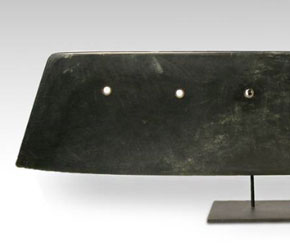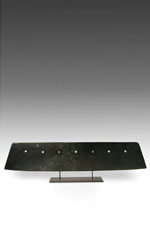| |
 |
| |
Chinese hardstone ritual blade (detail) |
Since
Neolithic
times, the
Chinese
have been master carvers of jade and other hard stone ritual and decorative objects. Various forms of hard stone artifacts have been dated to as early as 5000 BC, and they performed a ritual function in aristocratic burials as late as the
Han dynasty
(206BC to 222 AD). The actual meaning of these objects is not clearly known, but they were likely intended to help the soul of the deceased on its journey to heaven. Consequently, the enormous labor involved in perfecting their abstract shapes and lustrous finish is striking testimony to these symbols of wealth and prestige, and their more recent production represents the continuity of Chinese culture through the repetition and imitation of revered classical forms.
 |
|
|
|
Ceremonial blades
– large and often imposing blades of polished hard stone date back to stone-age cultures of China, which originally had to rely on stone for utilitarian
tools
and
weapons. Following the development of metal craft, these blades continued to be made as honorific symbols of power and rank.
Axes
were the earliest blades created and are represented by Yue, Fu, Chan forms. More ornate ceremonial blades, including the Zhang, Ge, and Ko, were often ostentatiously carved and inscribed with mythical and
anthropomorphic
designs.
These ceremonial stone designs were created in ages past for funerary and ritual purposes and to ease the spirit’s transition to a higher realm. In today’s home or office environment, they convey both prestige and a strikingly organic purity of design which can easily enhance both traditional and contemporary spaces.
Download this Article: Archaic Chinese Ceremonial Blades.pdf

